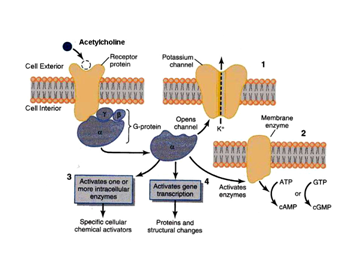Part 4: The Cholinergic Toxidrome
Section 3: Muscarinic Acetylcholine Receptors
- Learning Objectives
- Muscarinic, G-Protein Mediated Receptors
- Molecular Physiology of Muscarinic Receptors (Optional Reading)
- Molecular Structure and Physiology of Muscarinic Receptors (Optional Reading)
- Where Muscarinic Receptors Are Located
- Clinical Effects on the Peripheral Nervous System Due to Excessive Stimulation of Muscarinic Receptors
- Peripheral Muscarinic Effects
- Muscarinic Mnemonics
- Key Points
- Progress Check
Upon completion of this section, you will be able to:
- Describe the key ways that muscarinic receptors differ from nicotinic receptors.
- Describe where muscarinic receptors are found.
- Identify the key physiological effects that result from stimulation of muscarinic receptors by excessive amounts of acetylcholine.
The key response differences between muscarinic and nicotinic receptors is that the response of muscarinic receptors: (Hoffman and Taylor 2001)
- Is slower.
- May be excitatory or inhibitory.
- Do not affect skeletal muscles, but do influence the activity of smooth muscle, exocrine glands, and the cardiac conduction system. In contrast to skeletal muscle and neurons, smooth muscle and the cardiac conduction system normally exhibit intrinsic electrical and mechanical rhythmic activity. This activity is modulated, rather than initiated, by the muscarinic receptors. (Hoffman and Taylor 2001) For those interested in how muscarinic receptors work at the molecular level, the subject is covered in the Optional Reading below.
Muscarinic acetylcholine receptors — like nicotinic receptors — are proteins that extend through the cell membrane from the outside to the inside.
However, they do not contain channels to allow ions inside the cell. Instead, when acetylcholine attaches to the external part of the muscarinic receptor, the internal portion of the receptor releases large guanine nucleotide binding proteins (G-Proteins) (See note below), inside the cell. G-proteins then initiate other activities within the cell, such as smooth muscle contraction, gland excretion, etc. (Hoffman and Taylor 2001; Mailman and Lawler 2001; Guyton and Hall 2006)
Note on G-Proteins: Many functions of the nervous system (e.g., memory) require prolonged changes in neurons after the initial neurotransmitter is gone. Ligand-gated channels (such as those found in nicotinic receptors) are not suitable for this because the channels close in milliseconds. Prolonged changes can be achieved, however by activating G-proteins inside the post-synaptic neuron. It is then the G-proteins that trigger the prolonged effects. (Guyton and Hall 2006)
Muscarinic receptors are located in the: (See also Figure 5)
- Parasympathetic nervous system.
- Cardiac conduction system.
- Exocrine glands.
- Smooth muscles.
- Sympathetic nervous system.
- Sweat glands.
- Central nervous system.
Excessive Stimulation of muscarinic receptors due to cholinesterase inhibitor poisoning results in increased parasympathetic: (Erdman 2004)
- Cardiac effects.
- AV blocks, with escape rhythms.
- Bradycardia.
- Ventricular dysrhythmias.
- Exocrine gland activity.
- Bronchorrhea.
- Hyperamylasemia.
- Lacrimation.
- Rhinorrhea.
- Salivation.
- Smooth muscle activity.
- Bladder stimulation, sphincter relaxation.
- Bronchospasm.
- Miosis (pupillary constriction), eye pain due to ciliary spasm.
- Nausea, vomiting, cramps, diarrhea.
The table below summarizes the peripheral mostly parasympathetic* (muscarinic) effects of cholinesterase inhibitors. (Ecobichon 1996; Sidell 1997; Reigart and Roberts 1999; Tareg, B et al. 2001) (See also Figure 5)
*Sweat glands, which are enervated by the sympathetic nervous system, are activated via muscarinic receptors.
| End Organ Effected | Parasympathetic (Muscarinic) Effects |
|---|---|
| Respiratory tract |
|
| Eyes |
|
| Gastrointestinal tract |
|
| Urinary tract |
|
| Cardiovascular system |
|
| Exocrine glands |
|
Note: Reflex nausea and vomiting may occur with isolated eye exposure, even in the absence of systemic toxicity. (Sidell 1997)
Two mnemonics are helpful to remember the muscarinic (mostly parasympathetic*) peripheral effects of cholinesterase inhibitors. (Clark 2002; Robey and Meggs 2004)
*Sweating/diaphoresis is a muscarinic effect, but is actually mediated via the sympathetic nervous system.
| SLUDGE | DUMBELS |
|---|---|
| Salivation | Defecation/Diaphoresis |
| Lacrimation | Urination |
| Urination | Miosis (pupillary constriction) |
| Defecation | Bronchospasm and Bronchorrhea |
| GI pain | Emesis |
| Emesis | Lacrimation |
| Salivation |
- Muscarinic receptors respond more slowly than nicotinic receptors.
- The effects of muscarinic receptors may be excitatory or inhibitory.
- Muscarinic receptors do not affect skeletal muscles, but do influence the exocrine glands as well as the inherent activity of smooth muscles and the cardiac conduction system.
- In contrast to skeletal muscle and neurons, smooth muscle and the cardiac conduction system normally exhibit intrinsic electrical and mechanical rhythmic activity. This activity is modulated, rather than initiated, by the muscarinic receptors.
- With the exception of the sweat glands (enervated by the sympathetic nervous system), the peripheral nervous system effects (on the cardiac conduction system, exocrine glands, and smooth muscle) mediated by muscarinic receptors are parasympathetic.
